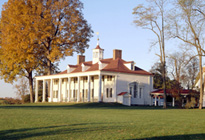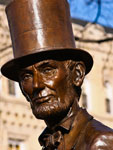Summer is often a time for professional development. Have you had a chance to learn new content and strategies and visit new places? Or revisit familiar content and places? Here's some of what our teacher-writer Elizabeth Schaefer took away from a summer professional development experience in Washington, DC.
A New Angle on Lincoln and the Civil War
As you plan out your next Civil War unit, consider approaching it from a new angle, a different place. The place, Lincoln's Cottage, is tucked up on the edge of northwest Washington, DC, alongside the Soldiers' Home and is now part of the Armed Forces Retirement Home complex. It was Abraham Lincoln's summer retreat and where he spent a large portion of his presidency. Lincoln's Cottage was closed to the public until 2008 but has opened its doors to tell a fresh story about the humanity of one of the country's greatest presidents.
Lincoln's Cottage in the Classroom
The story of Lincoln's cottage is a human story—one that students can understand. It was a place of personal refuge, grief, and contemplation. Lincoln lived there for a large portion of his presidency and very likely drafted the Emancipation Proclamation in the cottage. Using the cottage as something tangible, here are three themes that you could study in your class:
Lincoln and His Family:
Lincoln's Cottage is an ideal channel to ease students' imaginations into the Civil War unit. The Lincoln family left the White House and moved all of their belongings to the cottage after the death of 11-year-old Willie Lincoln. Paint the picture for your students—a grieving mother, a 9-year-old son who just lost his brother and best friend, and a father who is leading the nation through a civil war. A range of primary sources documenting each of these individuals exists and can be used to personalize the experience and create a human president that is less out of reach. On the cottage tour, visitors are asked to consider the significance of the cottage to a grieving family and the importance of reflection to everyone. The family continued to spend half the year there for the remainder of Lincoln's presidency.
War History:
During the Civil War, although Lincoln's Cottage was a comfortable distance from the heat and bustle of the city, the house was surrounded by reminders of war. Soldiers lived and camped in the surrounding areas and interacted with the family regularly.
This can aid understanding of what a civil war entails and how the impact on everyday life differed from the concept of war as we understand it in America today.
On the tour, there are fun accounts of Lincoln's encounters with soldiers and Tad Lincoln's friendships with them that students will greatly enjoy. There is also a soldiers' graveyard on the grounds. It did not exist when the family arrived, but by the time Lincoln was assassinated it was rapidly filling up with deceased young men. The cottage offers another avenue to consider the lives and deaths of the soldiers during the war.
Another way to look at the Civil War is through the position of this "retreat." A church bell tower within feet of the cottage was used to communicate with the forts surrounding Washington, DC, to warn of oncoming attacks. I suggest having your students find the cottage and the White House in relation to these Civil War forts. You can find maps and primary source materials at http://www.nps.gov/cwdw. This can aid understanding of what a civil war entails and how the impact on everyday life differed from the concept of war as we understand it in America today.
Historic Changes:
Another theme to consider is how America has changed over time. This will have special impact if your students are in the Washington, DC, area, but the big ideas likely translate to any city. The Lincolns fled to the cottage largely because Mary Todd blamed the horrible conditions of DC for the death of her son. There was a canal flowing directly in front of the White House, and the conditions were unsanitary—hot, bug-ridden, and dirty. Willie is believed to have died from typhoid fever. Not only does this paint a clearer picture of what the cities, hospitals, and battlegrounds were like during the war, it also makes an excellent introduction to the Progressive era and its urban reform campaigns.
What do we not understand about each other? What can we never fully understand from our position in time?
The cottage provides a canvas to humanize the president, but it also provides an opportunity for historic perspective-taking. These figures were living in the 1800s and had things in common with us—grief, fear, the need for quiet time—but what do we not understand about each other? What can we never fully understand from our position in time? Lincoln is assassinated at Ford's Theatre with no real security there to stop Booth's shot. Before that, for six months out of the year, he commuted the three miles between the cottage and the White House on horseback, often alone. This is an excellent opportunity to discuss why this could not happen today. What has changed about technology and what lessons have we learned? How would our understanding of the world be different if a president had never been assassinated? Are there things in the world that we take for granted until something bad happens and everything changes (i.e. security regulations)?
Visiting Lincoln's Cottage
The cottage is a unique historic site because, as explained on the tour, the National Trust "chose to furnish the cottage with Lincoln's ideas rather than his things." Sure enough, as you walk through the space, the rooms are basically empty and, with the help of technology, the rooms are used as platforms for discussion. Within the education center, students can participate in a roleplaying activity to discuss Lincoln's cabinet and their role in emancipation. The site offers free buses for DCPS and DC charter schools. Directions and further information can be found at www.lincolncottage.org.
Acknowledgements
I was introduced to this site by the Civil War Washington Teaching Fellows, led by a collaboration of small historic sites within Washington, DC, including Lincoln's Cottage, Ford's Theatre, Frederick Douglass House, and Tudor Place. They provided a wealth of information and resources about the Civil War and each added something to this post.
Callie Hawkins represented Lincoln's Cottage and through her understanding of its importance to President Lincoln, breathed life into the site and demonstrated its endless educational possibility.

